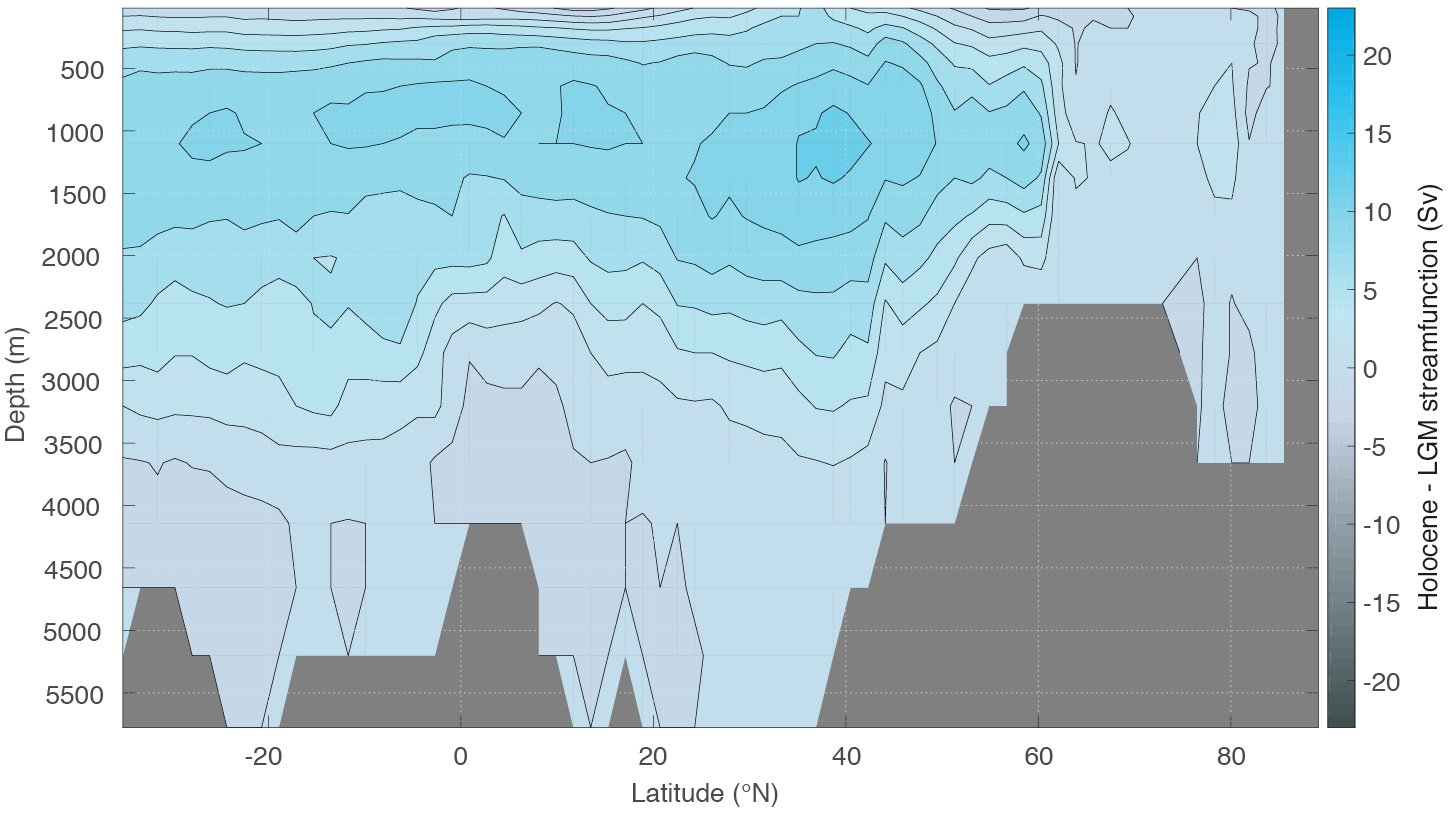- Home
- Publications
- PAGES Magazine
- Benthic Foraminiferal Stable Carbon Isotope Constraints On Deglacial Ocean Circulation and Carbon-cycle Changes
Benthic foraminiferal stable carbon isotope constraints on deglacial ocean circulation and carbon-cycle changes
Peterson CD, Gebbie G, Lisiecki LE, Lynch-Stieglitz J, Oppo D, Muglia J, Repschläger J & Schmittner A
Past Global Changes Magazine
27(2)
48-49
2019
Carlye D. Peterson1, G. Gebbie2, L.E. Lisiecki3, J. Lynch-Stieglitz4, D. Oppo5, J. Muglia6, J. Repschläger7 and A. Schmittner8
How does deep-ocean circulation influence atmospheric CO2 across deglacial transitions? Although biogeochemical and physical processes complicate interpretation of foraminiferal stable carbon isotope data, these complications can be addressed with expanded data compilations, multiproxy approaches, and model-data assimilation efforts.
The transition from glacial to interglacial climate involves carbon redistribution between the atmosphere, terrestrial biosphere, and ocean reservoirs. During repeated glaciations of the past ~1 million years (Myr), about 100 ppm of CO2 from the atmosphere was temporarily sequestered in the terrestrial biosphere and ocean. Although terrestrial biosphere carbon storage may have increased or decreased (see Jeltsch-Thömmes et al. 2019 and references therein) between the Last Glacial Maximum (LGM, ~20,000 years (20 kyr) before present) and the preindustrial period, the vast, deep-ocean reservoir most likely controls glacial-interglacial carbon cycling and, hence, atmospheric CO2 variations. On these timescales, ocean circulation and biological productivity influence carbon distribution in the deep ocean and regulate glacial carbon sequestration and deglacial CO2 outgassing. However, the details of these ocean changes and their role in modulating deep-ocean carbon storage remain poorly understood. Compilations of global benthic stable carbon isotopes (δ13C), such as those synthesized by the PAGES Ocean Circulation and Carbon Cycling (OC3, pastglobalchanges.org/oc3) working group, can help decipher these processes.
Ambiguity in proxy reconstructions
Past changes in ocean circulation and carbon storage have been reconstructed using the spatial distribution of stable carbon isotopes of dissolved inorganic carbon (DIC) inferred from stable carbon isotope records of benthic foraminifera Cibicides wuellerstorfi (and related genera) (δ13Ccib). These records are influenced by numerous fractionation processes including surface-ocean thermodynamic fractionation, air-sea gas exchange, and biological productivity (see Mackensen and Schmiedl 2019). These processes set the unique δ13C source properties of modern North Atlantic Deep Water (NADW) and its glacial counterpart. Processes that drive the low δ13C signature of the deep ocean include diabatic and turbulent mixing of water masses with different carbon isotope signatures during circulation and the degradation of surface-produced organic matter (remineralization) that subsequently sinks into the deep ocean. The low end-member δ13C signature of modern southern-sourced waters, such as Antarctic Bottom Water (AABW), is achieved through a combination of cold, dense waters forming under sea ice that are isolated from the atmosphere, water-mass mixing (see Talley 2013), and organic-matter remineralization during deep-water formation and transit. Quantifying different fractionation influences is one of the challenges to inferring past changes in deep-ocean circulation and carbon storage from δ13Ccib records.
One way to better constrain influences on δ13Ccib paleorecords is to increase the spatial coverage of high-resolution, well-dated δ13Ccib records. Even in relatively well-sampled regions such as the Atlantic Ocean, we must interpolate and extrapolate δ13Ccib values between core sites to capture spatial variations across ocean basins, which results in large uncertainties. To understand the temporal evolution of δ13Ccib, we rely on timeseries of δ13Ccib. High-resolution age models reduce the uncertainty in δ13Ccib timeseries, but δ13Ccib records with "high" temporal resolution (better than 3 kyr) are generally restricted to regions with high sedimentation rates and good carbonate preservation (e.g. the Atlantic Ocean). Thus, existing compilations are strongly dominated by regions with more favorable sedimentation regimes. Including low-resolution δ13Ccib records presents a trade-off between temporal and spatial resolution that is likely reasonable for characterizing the LGM and late Holocene time periods (Peterson et al. 2014).
Identifying locations of CO2 degassing can be challenging using δ13Ccib records because the strong air-sea exchange process "erases" the deep-ocean signature. However, independent nutrient proxies can help separate air-sea signals from recently upwelled deep waters (Lynch-Stieglitz et al. 2019). As such, multiproxy records allow us to estimate water-mass δ13C signatures at the time of their formation (i.e. "preformed" δ13CDIC), as well as their origin and transit (Oppo et al. 2018). Therefore, multiproxy records combined with well-dated, high-resolution δ13Ccib records from numerous locations across the seafloor allow us to reconstruct water-mass properties and explore the ocean circulation and carbon-cycling signals.
Additionally, systematic and regional deviations between late Holocene δ13Ccib and nearby seawater δ13CDIC estimates are found in more than 1700 δ13Ccib records of varying temporal resolutions (Schmittner et al. 2017). This compilation suggests that the carbonate ion content of seawater has a small (<15%) influence on δ13Ccib records. Although δ13Ccib and δ13CDIC lack a perfect one-to-one relationship, previous δ13Ccib interpretations likely hold (Schmittner et al. 2017). The effect of deep-ocean carbonate ion variations on glacial-interglacial δ13Ccib records remains to be evaluated.
Deglacial ocean circulation changes
Classical interpretations of glacial Atlantic Ocean δ13Ccib records propose a shoaled boundary between northern-sourced NADW and southern-sourced AABW at 2000 m water depth (Curry and Oppo 2005). This interpretation has since been tested with additional δ13Ccib records, with an expanded spatial distribution, and new model-data comparisons (e.g. Hesse et al. 2011). Recently, Oppo et al. (2018) argued that western North Atlantic waters shoaled by about 500 m during the glacial onset, consistent with the prevailing hypotheses that NADW shoaled while AABW expanded (Curry and Oppo 2005). However, it remains challenging to constrain ocean circulation changes in water-mass formation regions principally because the locations of deep-water formation shifted over time. Furthermore, changes in the source properties of water masses could explain changes previously attributed to carbon and nutrient storage change (Repschläger et al. 2015).
Modeling studies constrained by glacial-age δ13Ccib records indicate a shallow and weak Atlantic Meridional Overturning Circulation (AMOC) and enhanced Southern Ocean iron fertilization (Menviel et al. 2016; Muglia et al. 2018), although it remains to be determined how well δ13Ccib spatial variability constrains changes in AMOC strength versus depth. Additionally, model results indicate enhanced glacial Antarctic Intermediate Water (AAIW) formation in the Southern Hemisphere and a more closed circulation between NADW and AAIW (e.g. Ferrari et al. 2014). In the Atlantic Ocean, zonally averaged profiles of the difference between Holocene and LGM model-simulated seawater δ13CDIC and the δ13Ccib records used to constrain the model indicate a reduced deglacial vertical δ13Ccib gradient coinciding with reduced deep-ocean carbon storage in the same model runs (Fig. 1; Muglia et al. 2018). This is in agreement with results from fewer but higher-resolution deglacial δ13Ccib timeseries (Peterson and Lisiecki 2018). Complementary to this model run that best fits the δ13Ccib records (Fig. 1), the zonally averaged Atlantic stream function (Sverdrup, Sv) difference between the Holocene and LGM time periods indicates a deglacial strengthening of AMOC at intermediate depths (surface to ~1000 m) throughout the Atlantic Ocean (Fig. 2).
Two deglacial depth transects of δ13Ccib records from the Southwest Atlantic and Pacific oceans suggest that the depth of glacial NADW was shallower than the sill depth of the Drake Passage (approximately 2500 m), reducing the contribution of NADW to AABW formation (Sikes et al. 2017). Hence, glacial AABW may have been derived from Pacific Deep Water and Indian Deep Water (Sikes et al. 2017). Expanded abyssal AABW may have resulted from expanded sea ice (Ferrari et al. 2014), reduced basal melting of ice shelves (Miller et al. 2012) or reduced southward meridional water-vapor transport (Muglia et al. 2018). A strong LGM δ13Ccib gradient in the southeastern Atlantic, associated with the lowest δ13Ccib values in the glacial ocean, may indicate a more isolated version of Circumpolar Deep Water (CDW) distinct from the CDW that filled the Pacific and Indian oceans (Ullermann et al. 2016; Williams et al. 2019).
Conclusion
For more than 50 years, paleoceanographers have sought to characterize the link between deep-ocean circulation and CO2 cycling. To gain a better understanding of these processes, the traditional interpretation of δ13Ccib records should be re-evaluated and updated as we expand our understanding of the climate system and global carbon cycle. Collegial and interdisciplinary collaboration can foster new ideas and insights into the comparison between paleorecords and modeling approaches. By archiving our hard-earned, high-resolution multiproxy paleorecords, densely sampled age models, and model simulations in public databases online, we can improve reconstructions of ocean circulation and carbon-cycle changes based upon more complete paleodata compilations. Certainly, interpretations would benefit from improved age models and additional paleorecords from the Southern, Indian, and Pacific oceans. Together, we can synthesize our work to improve our understanding of carbon-cycle dynamics between global reservoirs and within the ocean, as well as changes in biological, physical, and chemical processes, for the past, present, and future. Community collaboration could help us extract more clues about the deglacial carbon cycle from the data we have already generated.
affiliations
1Department of Earth Sciences, University of California Riverside, USA
2Department of Physical Oceanography, Woods Hole Oceanographic Institution, MA, USA
3Department of Earth Science, University of California Santa Barbara, USA
4School of Earth and Atmospheric Sciences, Georgia Institute of Technology, Atlanta, USA
5Department of Geology and Geophysics, Woods Hole Oceanographic Institution, MA, USA
6Center for the Study of Marine Systems (CESIMAR), Centro Nacional Patagónico, National Scientific and Technical Research Council (CONICET), Puerto Madryn, Argentina
7Max Planck Institute for Chemistry, Mainz, Germany
8College of Earth, Ocean and Atmospheric Sciences, Oregon State University, Corvallis, USA
contact
Carlye Peterson: carlye.peterson gmail.com
gmail.com
references
Curry WB, Oppo DW (2005) Paleoceanography 20: PA1017
Ferrari R et al. (2014) P Natl Acad Sci 111 8753-8758
Hesse T et al. (2011) Paleoceanography 26: PA3220
Jeltsch-Thömmes A et al. (2019) Clim Past 15: 849-879
Lynch-Stieglitz J et al. (2019) Earth Planet Sc Lett 506: 466-475
Mackensen A, Schmiedl G (2019) Earth-Sci Rev 197: 102893
Menviel L et al. (2016) Paleoceanography 32: 2-17
Miller MD et al. (2012) Paleoceanography 27: PA3207
Muglia J et al. (2018) Earth Planet Sc Lett 496: 47-56
Oppo DW et al. (2018) Paleoceanogr Paleocl 33: 1013-1034
Peterson CD et al. (2014) Paleoceanography 29: 549-563
Peterson CD, Lisiecki LE (2018) Clim Past 14: 1229-1252
Repschläger J et al. (2015) Earth Planet Sc Lett 425: 256-267
Schmittner A et al. (2017) Paleoceanography 32: 512-530
Sikes EL et al. (2017) Paleoceanography 32: 1000-1017
Talley LD (2013) Oceanography 26: 80-97


